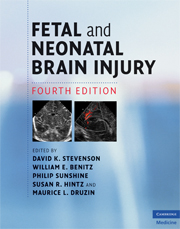Book contents
- Frontmatter
- Contents
- List of contributors
- Foreword
- Preface
- Section 1 Epidemiology, pathophysiology, and pathogenesis of fetal and neonatal brain injury
- Section 2 Pregnancy, labor, and delivery complications causing brain injury
- Section 3 Diagnosis of the infant with brain injury
- Section 4 Specific conditions associated with fetal and neonatal brain injury
- Section 5 Management of the depressed or neurologically dysfunctional neonate
- 39 Neonatal resuscitation: immediate management
- 40 Improving performance, reducing error, and minimizing risk in the delivery room
- 41 Extended management following resuscitation
- 42 Endogenous and exogenous neuroprotective mechanisms after hypoxic–ischemic injury
- 43 Neonatal seizures: an expression of fetal or neonatal brain disorders
- 44 Nutritional support of the asphyxiated infant
- Section 6 Assessing outcome of the brain-injured infant
- Index
- Plate section
- References
41 - Extended management following resuscitation
from Section 5 - Management of the depressed or neurologically dysfunctional neonate
Published online by Cambridge University Press: 12 January 2010
- Frontmatter
- Contents
- List of contributors
- Foreword
- Preface
- Section 1 Epidemiology, pathophysiology, and pathogenesis of fetal and neonatal brain injury
- Section 2 Pregnancy, labor, and delivery complications causing brain injury
- Section 3 Diagnosis of the infant with brain injury
- Section 4 Specific conditions associated with fetal and neonatal brain injury
- Section 5 Management of the depressed or neurologically dysfunctional neonate
- 39 Neonatal resuscitation: immediate management
- 40 Improving performance, reducing error, and minimizing risk in the delivery room
- 41 Extended management following resuscitation
- 42 Endogenous and exogenous neuroprotective mechanisms after hypoxic–ischemic injury
- 43 Neonatal seizures: an expression of fetal or neonatal brain disorders
- 44 Nutritional support of the asphyxiated infant
- Section 6 Assessing outcome of the brain-injured infant
- Index
- Plate section
- References
Summary
Introduction
After the initial resuscitation of an encephalopathic infant, the extended management of the patient becomes critical in order to prevent as much secondary damage as possible. There are many different management protocols that are acceptable, and it is not the intent of this chapter to review all of them used for the various conditions encountered in neonatal intensive care. Rather, we focus on the early transitional period following birth and resuscitation, during which the condition of the depressed infant can be substantially improved by expert care.
As noted in Chapters 2 and 42, the encephalopathic period involves a continuum of biologic events associated with secondary energy failure lasting up to 48–72 hours after the initial insult. These include the reperfusion period with the elaboration of oxygen free radicals and various cytokines as well as necrosis and apoptosis that then ensue. It is imperative that the extended management of these infants be carried out in an optimal fashion at a center that can provide hypothermia or other novel neuroprotective interventions that may be developed.
Unfortunately, the windows of opportunity may be short and variable depending upon the nature of the intervention, and could change as further research informs practice. Thus there is an obligation for the practitioner to be well informed about progress in the standard of care and to stay current with respect to neuroprotective strategies. Various neuroprotective mechanisms after hypoxic–ischemic injury are discussed in detail in Chapter 42.
- Type
- Chapter
- Information
- Fetal and Neonatal Brain Injury , pp. 470 - 484Publisher: Cambridge University PressPrint publication year: 2009



